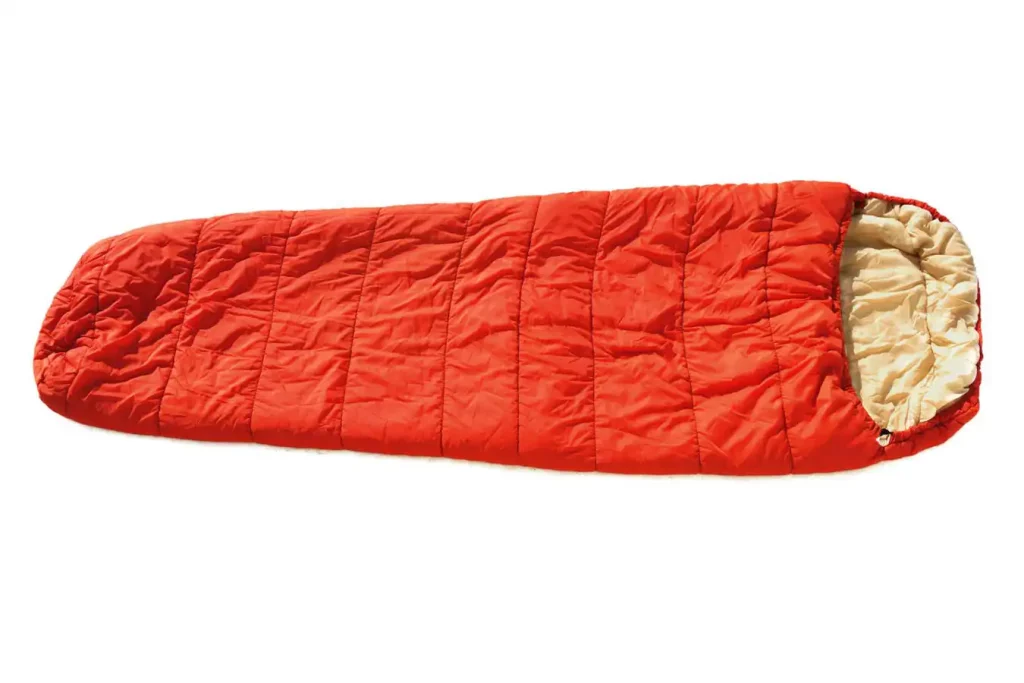“What material are sleeping bags made of?” Ever wondered about that during a cozy campfire night?
It’s not just fluff and fabric; there’s real science behind that snug embrace. The secret to that cloud-like comfort isn’t magic, but science and smart design.
Choosing the right material can be the difference between counting sheep and shivering sheepishly.
Comfort isn’t just about softness; it’s about staying warm, dry, and happy outdoors.
Let’s unzip the mysteries together and find your perfect sleep cocoon!
The Fundamentals of Sleeping Bag Materials
Every sleeping bag is essentially a sandwich of various materials, each serving a specific purpose. Let’s peel back the layers and take a closer look at how each one contributes to your cozy camping sleep.
Understanding Sleeping Bag Construction
Inner Lining
First up, the inner lining. This is the layer that you actually slip into when you crawl into your sleeping bag. It needs to feel comfortable against your skin, wick away moisture (because no one likes waking up clammy), and help retain heat. Materials like nylon, polyester, or a blend of both are commonly used due to their lightweight, breathable, and moisture-wicking properties.
Insulation
The heart of a sleeping bag is its insulation – the material responsible for trapping your body heat and creating a cozy microclimate. There are two main types of insulation: down and synthetic. Down, usually sourced from ducks or geese, is renowned for its excellent warmth-to-weight ratio and compressibility, making it ideal for lightweight backpacking trips. However, it loses its insulating properties when wet and can be expensive.

On the other hand, synthetic insulation (typically made from polyester fibers) is cheaper, quick-drying, and insulates even when wet, but it’s bulkier and less efficient in terms of warmth-to-weight.
Outer Shell
Finally, the outer shell of a sleeping bag (Amazon) has to be sturdy enough to withstand the rigors of camping while also providing some level of water resistance. Materials like ripstop nylon or polyester are common due to their durability. Some outer shells also have a durable water repellent (DWR) coating to prevent the insulation from getting damp.
Role of Different Materials in a Sleeping Bag
Comfort
Materials used in sleeping bags are selected for comfort as well as functionality. The inner lining, for example, is often made from soft, skin-friendly materials that feel pleasant to touch and help wick away sweat.
Warmth Retention
The primary function of a sleeping bag is to keep you warm. That’s where the insulation comes in, trapping warm air and creating a thermal barrier against the cold. The type of insulation (down vs. synthetic) can greatly impact the sleeping bag’s performance in different conditions.
Weather Resistance
Whether you’re camping in a dewy meadow or a frosty mountain, your sleeping bag needs to handle the elements. The outer shell, often made from durable, water-resistant materials, protects you and the bag’s insulation from the weather.
Sleeping bags are typically made of three key components – an inner lining commonly made from polyester, nylon, or silk; insulation often using synthetic materials like polyester fibers or natural materials such as down feathers; and an outer shell that frequently uses materials like polyester, ripstop nylon, or specially designed fabrics such as Dryloft for enhanced weather resistance.
The materials that make up your sleeping bag are integral to its performance. A well-made sleeping bag, designed with the right materials, can ensure you sleep soundly no matter where your adventures take you.
Read more: Material Provides Warmth Even When Wet
Common Material are Sleeping Bags Made Of
When it comes to the sleeping bags, the choice of materials is crucial. They dictate everything from warmth and comfort to durability and weight. Let’s dive into the specifics and examine the most common materials used in sleeping bags.
Inner Lining Materials
Polyester
Polyester is a popular choice for the inner lining of sleeping bags. It’s soft to the touch, making it comfortable against your skin, and it wicks away moisture, ensuring you stay dry throughout the night. It’s also easy to clean, which is a big plus after several nights in the great outdoors.
Nylon
Nylon is another common material used in sleeping bag liners. It shares many of the same qualities as polyester – it’s soft, moisture-wicking, and easy to clean – but it’s generally more durable. Nylon also tends to be a bit pricier than polyester, but the added durability can be worth the extra investment for heavy-duty campers.
Silk
The Silk, though less common, offers a luxurious feel and excellent breathability. Silk liners can add a touch of comfort to your outdoor snoozing. However, silk is more delicate than polyester or nylon, requiring more careful handling and cleaning.
Insulation Materials
Synthetic Insulation: Polyester Fibers
Synthetic insulation, most commonly made from polyester fibers, is a reliable choice for a wide range of conditions. It’s relatively cheap, hypoallergenic, and performs well even when wet, drying out faster than down. However, it’s bulkier and heavier than down, and it doesn’t compress as well, making it a less optimal choice for backpacking where space is a premium.
Natural Insulation: Down Feathers
Down feathers, usually harvested from ducks or geese, offer superior warmth-to-weight ratio and compressibility. This makes down sleeping bags ideal for colder climates and backpacking trips where weight and pack size are key considerations. The downside (pun intended) is that they lose much of their insulating power when wet and they are more expensive than their synthetic counterparts.
Learn more: What Size Compression Sack for Sleeping Bag
Outer Shell Materials
Polyester
Once again, polyester shows up in our list, this time as a common material for sleeping bag shells. Its durability and resistance to wear and tear make it an excellent choice for the outer layer that faces the most exposure to rough handling and the elements.
Ripstop Nylon
Ripstop nylon is another common choice for the outer shell of a sleeping bag. As the name suggests, this fabric is woven in a way that stops tears from spreading, enhancing the durability of the sleeping bag. Some ripstop nylon shells also feature a water-resistant coating for added weather protection.
Dryloft
Dryloft is a high-performance fabric designed specifically for sleeping bags and other outdoor gear. It’s highly water-resistant, yet breathable, making it a fantastic choice for keeping the insulation dry in damp conditions.
Specialized Materials and Technologies in Sleeping Bags
With advancements in technology, the humble sleeping bag has seen numerous upgrades and enhancements that make it more resilient to harsh weather conditions while still being comfortable and breathable. In this section, we’re going to look at specialized materials and technologies that have revolutionized sleeping bags.
Waterproof and Water-Resistant Materials
These are materials designed to provide an additional layer of protection against wet conditions. They help keep the insulation dry, ensuring that your sleeping bag retains its heat-trapping abilities even in the dampest of conditions.
Treated Down
Down, while offering unparalleled warmth and compressibility, has a known weakness: it clumps up and loses its insulating properties when wet. Enter treated down. This is down that has been treated with a water-resistant compound, helping the feathers resist moisture and dry faster when they do get wet. This gives you the warmth of down with better performance in damp conditions.
Hydrophobic Coatings
Hydrophobic coatings are applied to the outer shell of the sleeping bag to repel water. They allow water to bead up and roll off the surface rather than soaking in. This is a common feature on both down and synthetic sleeping bags, extending their usability in wet conditions.
Breathable Materials
Breathability is just as important as waterproofing when it comes to sleeping bag materials. A breathable sleeping bag allows moisture from your body (sweat, breath, etc.) to escape, helping to regulate your temperature and prevent a damp, clammy feeling inside the bag.
Proprietary Technologies (e.g., Gore-Tex)
Some manufacturers have developed their own proprietary materials that combine breathability with water-resistance. One such technology is Gore-Tex. Often used in outerwear and shoes, Gore-Tex is also found in some high-end sleeping bags. It’s a membrane with microscopic pores, each too small for water droplets to pass through, but large enough for water vapor (like sweat) to escape. This means it can keep the rain out while still allowing your sleeping bag to breathe.
How Material Choice Impacts Sleeping Bag Function
Now that we’ve explored the different materials used in sleeping bags, it’s time to delve into how these materials can significantly impact the functionality of a sleeping bag. From comfort and warmth to durability and maintenance, the choice of material can make a big difference.
Comfort Factors
The inner lining material is the primary contributor to a sleeping bag’s comfort level. Materials like silk and high-quality polyester offer a soft and smooth touch, adding to the overall comfort during sleep. A breathable lining will also contribute to a better sleeping environment by reducing dampness inside the bag.
Warmth and Insulation
Insulation is the heart of a sleeping bag when it comes to warmth. Down insulation, for instance, offers excellent warmth-to-weight ratio and compressibility, making it a great choice for cold conditions. However, it can lose its insulating properties when wet. Synthetic insulation, while heavier and less compressible, maintains its insulation even when damp. Water-resistant technologies can make both down and synthetic insulation more suitable for wet conditions.

Weight and Portability
Every camper, hiker, or backpacker knows that every ounce counts when packing for a trip. Here, the materials used in your sleeping bag can impact its weight and packability. Down, being lighter and more compressible, is excellent for minimizing weight and pack size. On the other hand, synthetic materials, though generally heavier, can still be a good option for short trips where weight is not a significant concern.
Durability and Lifespan
The outer shell material often determines the durability of a sleeping bag. Ripstop nylon and polyester are popular choices for their resistance to tears and overall durability. Coatings and treatments for water-resistance can also contribute to longevity by protecting the insulation.
Ease of Maintenance
Some materials are easier to clean and maintain than others. Synthetic sleeping bags, for example, are usually machine washable and dry quicker than down. Down sleeping bags require special care during washing and drying to maintain their loft and insulating properties.
How to Choose the Right Sleeping Bag Material
As we’ve seen, sleeping bag materials greatly influence the comfort, warmth, portability, and durability of the bag. But how do you determine which materials are the right ones for you? Let’s explore some key factors you should consider when choosing the perfect sleeping bag for your needs.
Consideration of Weather and Climate
Your first step in selecting a sleeping bag should be to consider the weather and climate of your intended camping location. For instance, if you’re heading towards a wet and damp environment, a synthetic bag with a water-resistant outer shell would be a better choice. This is because synthetic materials retain their insulating properties even when wet.
On the other hand, if you’re off to a very cold but dry location, a down-filled sleeping bag might be your best bet. Down is lightweight, compressible, and has excellent insulation properties for those chilly nights.
Personal Comfort Preferences
The next factor to consider is your personal comfort preference. If you’re someone who prefers a soft, plush sleeping surface, then a sleeping bag with a silk or a high-quality polyester lining might be for you. If breathability is important to you, consider a bag with materials designed for this, such as those incorporating proprietary technologies like Gore-Tex.
Intended Use (Hiking, Camping, Mountaineering etc.)
Your intended use of the sleeping bag also influences your material choice. If you’re backpacking or hiking, where every ounce of weight counts, a sleeping bag with lightweight materials like down insulation and ripstop nylon shell should be on your checklist.
For car camping, where weight is less of a concern, you might opt for a more comfortable and roomier bag, which could mean thicker materials and therefore more weight. If you’re mountaineering, a heavy-duty, well-insulated bag is essential, and you might want to look for bags featuring treated down for a combination of warmth and water-resistance.
Budget Considerations
Lastly, but by no means least, your budget will have a significant influence on your choice. High-quality down and specialized materials can increase the cost of sleeping bags. Synthetic bags, while they might not offer the same performance in extreme conditions, can be an excellent budget-friendly choice.
Choosing the right sleeping bag material can be a bit of a juggling act, balancing comfort, weather suitability, intended use, and budget. But armed with the knowledge you now have, you’ll be better equipped to make an informed decision to enhance your outdoor adventures.
Know more: Material is a Backpack Made Of
FAQs about Material are Sleeping Bags Made Of
What is the best material for sleeping bags?
Why are sleeping bags polyester?
What are winter sleeping bags made of?
Is nylon or polyester better for a sleeping bag?
Final Words about Sleeping Bags Material
As we’ve traveled through the world of sleeping bag materials, we’ve recognized the substantial role materials play in the bag’s performance, comfort, warmth, and overall functionality. Whether it’s the snug inner lining, the heat-preserving insulation, or the weather-resistant outer shell, every layer has a unique purpose. All these materials combined dictate your experience under the stars, providing either a pleasant night’s sleep or a chilly, uncomfortable awakening.
Final tips? Take a close look at the materials used in your next sleeping bag. Consider your specific needs—comfort preferences, weather conditions, budget, and more. Remember, there’s no one-size-fits-all solution, and that’s the beauty of it. Your perfect sleeping bag, tailored to your unique outdoor adventure, is waiting out there. So, delve in, investigate, and let your newfound knowledge guide you to the sleeping bag that will best suit your needs.
To know more: What to Do if Your Down Sleeping Bag Gets Wet


